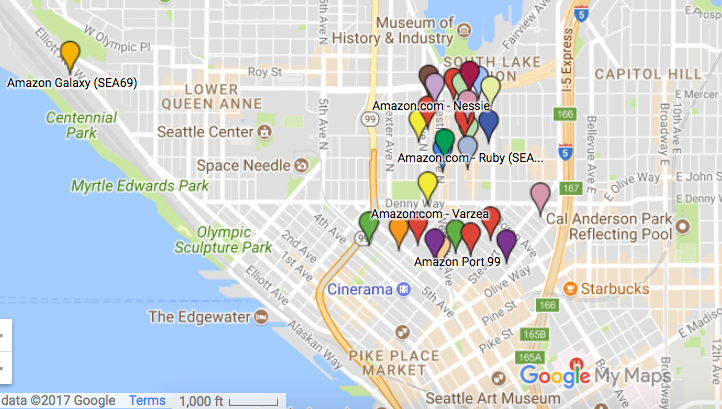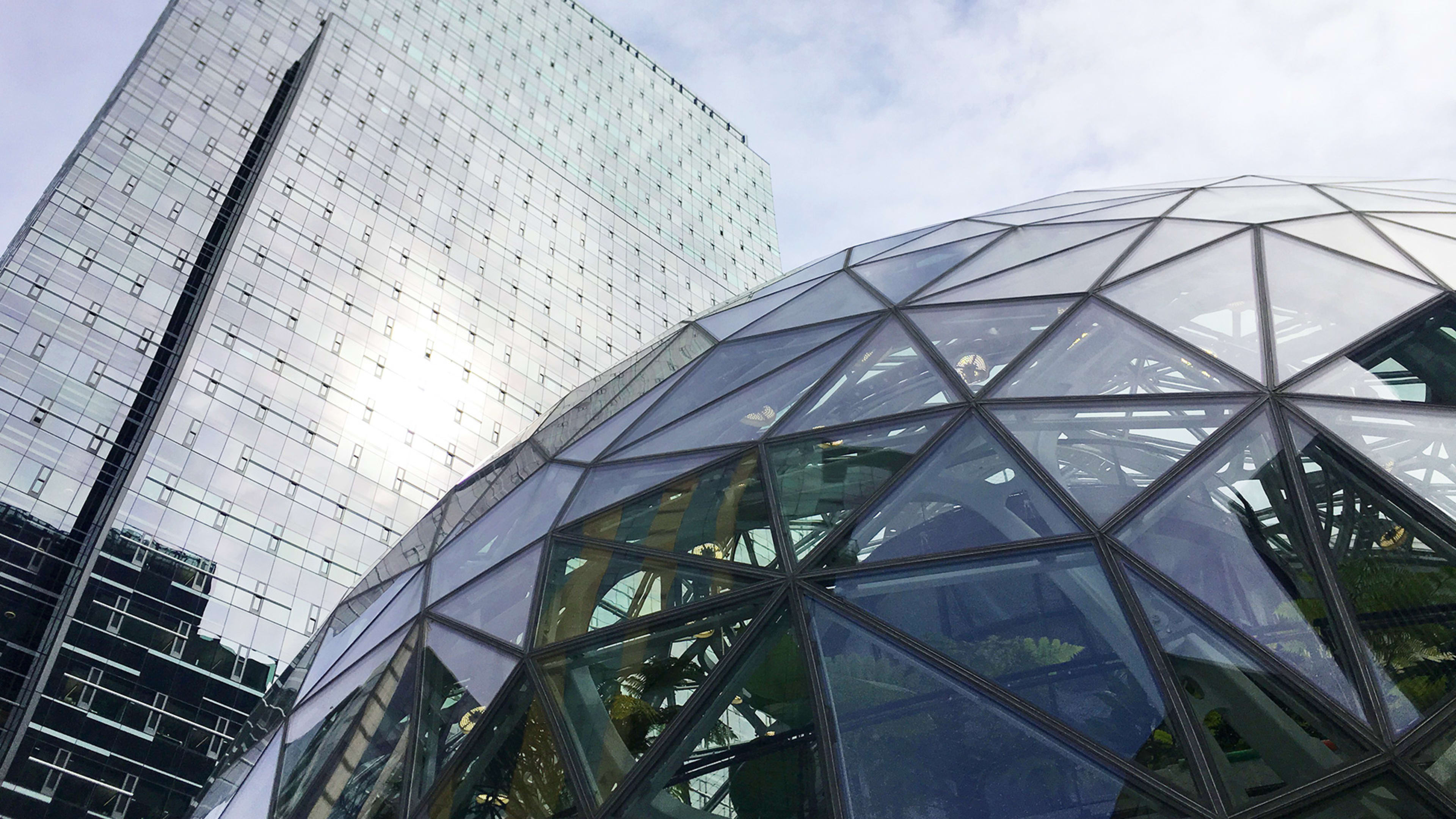“I want us to stay in Seattle,” said Jeff Bezos.
A few weeks ago, that statement—made in 2005 by Amazon’s founder and CEO—was relayed to me in a company conference room by John Schoettler, the company’s vice president of global real estate and facilities. A few days ago, Amazon said it was looking to build out $5 billion in new offices and hire 50,000 to create a duplicate of Seattle, which it’s dubbed HQ2. The place for which it longs has “strong local and regional talent—particularly in software development and related fields,” as well as a “stable and business-friendly environment,” according to a dedicated website. “We want to find a city that is excited to work with us, and where our customers, employees, and the community can all benefit.”
At first glance, maybe it seems disingenuous that Schoettler brought up Bezos’s blunt statement given the obvious timing of the HQ2 plan. (Not that Amazon should have blabbed to me in advance: It didn’t even let Seattle leaders know.) Or maybe the move was, as the local paper’s unsigned editorial insists, the outcome of the city’s “poor planning and anti-business posturing”? Many local and state officials weighed in with their responses to the notion of a Seattle replicant elsewhere in North America; many considered it a surprising move. But given how, as I reported last month, Amazon’s nonstop growth has already transformed Seattle, the decision isn’t entirely surprising. Nor was Schoettler quoting Bezos out of keeping with the new plan.
The company has outstripped Seattle’s geographical and recruiting capacity. Amazon already owns or leases over 8 million square feet with an existing plan to expand to 12 million square feet over the next few years. It’s already the single-biggest downtown tenant, with 90% of prime real estate there, and among the largest footprints of any non-manufacturing business across the region. The second-biggest Seattle property occupier is Safeco, with 411,000 square feet. (Microsoft has more office space in its suburban campus and outposts, but they started building long before the current boom at lower cost and low density.)
Seattle may not technically be a “company town,” but Amazon now occupies more than twice as many square feet as any other company in any other big U.S. city. In contrast, San Francisco, which has about 20% more office space than Seattle, has only a handful of companies approaching 1 million square feet, and that includes Google.

Related: Amazon’s Can Microsoft Co-Founder Paul Allen Reboot “The Best Music Scene In The World?
Then there’s the problem of hiring tech workers: Amazon has thousands of jobs it’s trying to fill now and in the near future, and expects to hire on the order of 10,000 more beyond that in Seattle based on its current rough target of 50,000 as it continues to build out and grow. The University of Washington, to which Amazon donated $10 million last year toward a new computer science building, and other regional schools can only mint so many qualified candidates, and Amazon can only poach a finite number of workers from other local companies.
Convincing people to move from anywhere but other super-hot housing markets to Seattle is a stretch as well, even with the salaries on offer. And opening a Microsoft-like satellite campus in the region doesn’t help with recruiting: The kinds of employees Amazon focuses on want a college campus/lifestyle mall-style work location, not an isolated suburban commute.
There is some truth to one complaint, however. Seattle’s city leadership across decades and many different sets of mayors and city councillors has done a terrible job—albeit, maybe not quite as terrible as San Francisco, New York, and some other metropolitan areas—at providing and executing a comprehensive plan for increased housing density paired with affordable housing. Pro-density forces have always contended with NIMBYs, and developers here, as elsewhere, naturally want to follow the money and build the most expensive houses, condos, and apartments the market can sustain.
As a result, Amazon’s massive influx of jobs and money caused house and rental prices to skyrocket—the fastest rising in the country. Unlike previous booms, this isn’t driven by illusory stock values but actual revenue and profits that drive sales and stock ownership (and sales of stock) by employees and executives at many different companies, including the thousands of Apple, Facebook, and Google employees located in the region. That’s kept the market on fire, and it’s unlikely to drop. Many locals hope it just slows down. The city’s culture is at stake, some say, in spite of efforts like those of Microsoft cofounder Paul Allen to foster the local art scene.
And even as Seattle has increased its minimum wage and has extremely low unemployment, housing costs far outstrip the gains in income for those even at the median income in Seattle—$75,000 in 2015, and likely near $80,000 today. Seattle has a larger per-capita homeless population than any major city in the U.S., after the far-larger metropolises of New York and Los Angeles.
Amazon has become a better corporate citizen in recent years. Its campus buildout has resulted in mostly attractive buildings and interesting spaces, as well as a diversity of locally owned restaurants. Its charitable giving and support of nonprofits downtown has finally stepped up to approach the scale of company it is. The local buzz is that it’s had to become a better employer, too, especially after a devastating New York Times article in October 2015 recounting employees crying at their desks. It hasn’t become warm and fuzzy, but it’s taken some edge off its sharpness as it competes for employees and needs things from the community.
However, Amazon’s announcement even seemed to take the mayor’s office by surprise. “My office will immediately begin conversations with Amazon around their needs with today’s announcement and the company’s long-term plans for Seattle,” Mayor Ed Murray said in a statement. “And we will coordinate with [Washington Governor Jay Inslee] to convene key business and community leaders to plan for our future growth and response to this announcement. I look forward to working with Amazon to secure their long-term, successful future in the heart of Seattle.” [Update: On Sept. 12, Mayor Murray announced he would resign the following day after a fifth man accused him of abuse. The Mayor has denied the allegations. City Council member Bruce Harrell will fill the post for the next five days.]
There’s suspicion among some leaders and local businesspeople that HQ2 is a plan to extract concessions from Seattle and Washington, while also demanding huge amounts of tax deferrals and credits in the city the company picks. With two HQs, the company can pit the two cities against each other for future divisions and buildouts. (The New York Times crunched the data and the criteria Amazon’s made part of its HQ2 RFP, and landed on . . . Denver!)
Seattle city councilperson Kshama Sawant, elected as a socialist and who is a robust advocate for a livable wage, released a statement comparing Amazon’s plan to tactics used by another major local employer, Boeing, which officially moved its headquarters—and a small number of staff—to Chicago in 2001: “For decades, Boeing executives and billionaire shareholders have carried out systematic economic extortion by pitting cities and states against one another, forcing a race to the bottom for the living standards of workers, and crushing labor unions.”
Related: Why Amazon Is The World’s Most Innovative Company Of 2017
Amazon, always aggressive in strategy, will certainly pursue whatever leverage it can. But the fundamental truth is that there are limits to growth to recruit and retain the employees Amazon wants at the density of office space it needs within the limits of the ability to move them between home and work each day. Amazon, like Facebook and tech companies in the first tier of the pantheon, have ambition and growth that sometimes seems constrained only by the size of the internet. Cities have more physical limits.
Recognize your brand’s excellence by applying to this year’s Brands That Matter Awards before the early-rate deadline, May 3.
